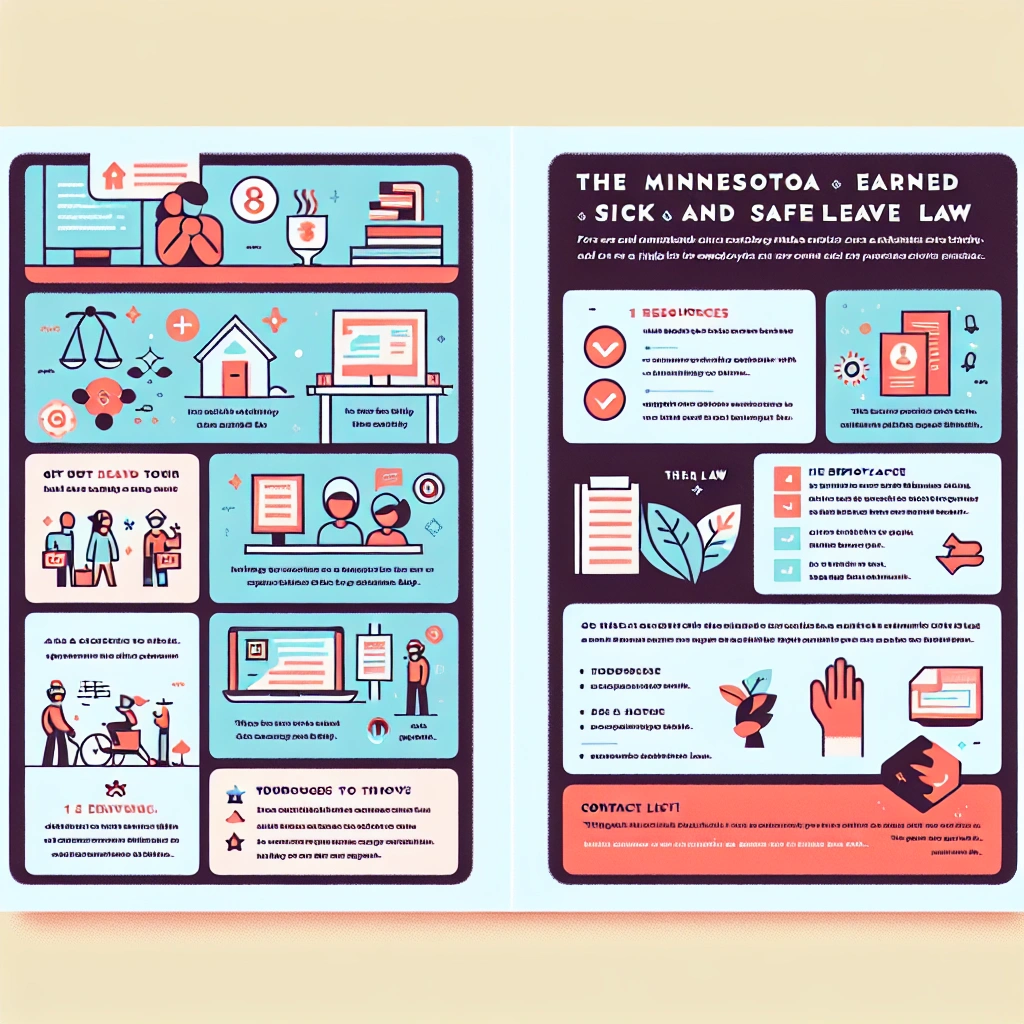Minnesota Earned Sick And Safe Leave Law: Your Rights And Benefits
Short Answer for Minnesota Earned Sick and Safe Leave Law
Yes, Minnesota has an earned sick and safe leave law, which provides paid leave to eligible employees for various reasons such as illness, caregiving, and seeking assistance in cases of domestic abuse, sexual assault, or stalking.
Sick and safe time is paid leave provided to employees in Minnesota for various reasons, including when an employee is sick or needs to care for a sick family member.
Employees who work in Minnesota and have completed at least 80 hours of work in a year are eligible for sick and safe time.
Check out this Youtube video: Learn about the new Minnesota earned sick and safe time law and how it may impact you as an employee or employer.
Key Takeaways on Minnesota Earned Sick and Safe Leave Law
-
Employees in Minnesota can earn one hour of sick and safe time for every 30 hours worked, with a maximum accrual limit of 48 hours each year.
-
Sick and safe time in Minnesota must be paid at the same hourly rate that the employee earns when they are working.
-
The law applies to temporary and part-time employees, emphasizing inclusivity.
-
Employers in Minnesota are required to provide at least one hour of paid sick and safe time for every 30 hours worked, and maintain accurate records of employees’ work hours and accrued sick and safe time.
-
Sick and safe time local ordinances are effective in Bloomington, Minneapolis, and St. Paul, and individuals should familiarize themselves with their respective city-specific regulations.
Earning and Using Sick and Safe Time in Minnesota
Employees in Minnesota can earn sick and safe time based on their hours worked. According to the Minnesota Department of Labor and Industry, an employee can earn one hour of sick and safe time for every 30 hours worked. However, there is a maximum accrual limit of 48 hours each year, unless the employer agrees to a higher amount.
At what rate must sick and safe time be paid?
Sick and safe time in Minnesota must be paid at the same hourly rate that the employee earns when they are working. This means that employees will receive their standard hourly wage for the sick and safe time they take.
To shed more light, let’s look at a hypothetical example: Suppose an employee in Minnesota earns $15 per hour. When this employee uses their earned sick and safe time, they should be paid at the same rate of $15 per hour.
What can sick and safe time be used for?
Sick and safe time in Minnesota can be used for various important purposes. These include:
-
When an employee is sick and needs to take care of their health.
-
To care for a sick family member and provide the necessary support and assistance.
-
In situations where an employee or their family member has experienced domestic abuse, sexual assault, or stalking. This provision allows the employee to seek support and aid during difficult times.
To provide further clarity, let’s take an instance: If an employee’s child falls sick and requires parental care, the employee can use their earned sick and safe time to tend to their child’s health needs.
Here’s a table summarizing the key points related to sick and safe time in Minnesota:
| Key Point | Explanation |
|---|---|
| Sick and Safe Time Acquisition | Employees earn one hour of sick and safe time for every 30 hours worked. |
| Maximum Accrual Limit | The maximum accrual limit is 48 hours each year, unless the employer agrees to a higher amount. |
| Sick and Safe Time Payment Rate | Sick and safe time must be paid at the same hourly rate an employee earns when they are working. |
| Usage of Sick and Safe Time | Sick and safe time can be used for the employee’s illness, caring for a sick family member, or seeking assistance in case of domestic abuse, sexual assault, or stalking. |
The earned sick and safe leave law in Minnesota provides essential provisions for employees to earn and use sick and safe time, ensuring their well-being and that of their family members when faced with adversity.

Employer Responsibilities Under the Minnesota Earned Sick and Safe Leave Law
The Minnesota Earned Sick and Safe Leave Law requires employers to provide each employee in Minnesota at least one hour of paid sick and safe time for every 30 hours worked, accumulating to at least 48 hours of accrued ESST in a year. This necessitates employers to carefully track and maintain accurate records of their employees’ work hours and the corresponding earned sick and safe time. Failure to comply with these responsibilities could lead to legal consequences and negatively impact the employer’s reputation.
In addition to tracking and providing paid ESST, employers in Minnesota must also ensure that their employee handbooks include a statement outlining the rights of employees under the Earned Sick and Safe Leave Act. This ensures that employees are well-informed about their entitlements and can readily access information regarding their ESST benefits. Furthermore, employers are required to send a formal notice as mandated by the statute to each employee affected by the law, ensuring transparency and legal compliance.
For practical management of ESST responsibilities, employers must also ensure that their employee earnings statements are in accordance with the ESST tracking requirements. This involves meticulous record-keeping and systematic monitoring of employees’ accrued sick and safe time to facilitate transparent communication and fair treatment of all individuals within the organization.
These responsibilities demand a proactive and practical approach to managing employee sick and safe time, prioritizing transparency and compliance.
Moreover, the law extends its coverage to temporary and part-time employees, emphasizing the inclusivity of the ESST requirements. This broad scope necessitates employers to implement comprehensive measures that cater to the needs of all employees, regardless of their employment status. The consistent provision of ESST for all eligible employees contributes to fostering a supportive and equitable work environment, aligning with the state’s commitment to employee well-being.
Furthermore, the law specifies that earned sick and safe time can be utilized for various important reasons, including instances when an employee is ill, needs to care for a sick family member, or requires assistance due to domestic abuse, sexual assault, or stalking. Employers need to acknowledge these specific circumstances and facilitate the utilization of ESST in a supportive and understanding manner, showcasing empathy and consideration for their employees’ well-being.
Employers bear the crucial responsibility of not only providing paid sick and safe time as mandated by the Minnesota ESST law but also ensuring comprehensive compliance with tracking, notification, and handbook inclusion, while compassionately addressing their employees’ diverse needs.

Resources and Contacts for Minnesota Earned Sick and Safe Leave Law
Current sick and safe time local ordinances
In Minnesota, the earned sick and safe time (ESST) law has been incorporated into local ordinances in certain cities. Presently, ESST local ordinances are effective in Bloomington, Minneapolis, and st. Paul.
Each city may have its specific nuances and regulations regarding ESST, and it’s essential for employers and employees to familiarize themselves with the respective local ordinances. Generally, sick and safe time refers to the paid leave that employers are required to provide to employees in Minnesota for various reasons such as illness, caregiving, or seeking assistance in cases of domestic abuse, sexual assault, or stalking.
To delve deeper into city-specific sick and safe time ordinances in Minnesota, individuals should consult the respective city authorities or legal resources to gain a comprehensive understanding of the regulations and provisions applicable within their locality. By understanding the local ordinances, employers and employees can ensure compliance and make informed decisions regarding sick and safe time benefits and entitlements.
This information is crucial for fostering a harmonious work environment and ensuring that employees’ rights to sick and safe time are upheld.
Resources
For comprehensive information and guidance on Minnesota’s earned sick and safe time law, the Minnesota Department of Labor and Industry (DLI) serves as an invaluable resource. The DLI provides a wealth of resources, including detailed guidelines, official communications, frequently asked questions (FAQs), and outreach toolkits, to assist employers and employees in understanding and implementing the ESST law effectively.
Employers can access resources to ensure compliance with ESST provisions, while employees can obtain information to understand their rights regarding sick and safe time benefits.
Additionally, the DLI offers email updates for individuals interested in staying abreast of the latest developments and updates related to Minnesota’s ESST law. By subscribing to these updates, both employers and employees can receive timely notifications about any changes, clarifications, or additional resources pertaining to sick and safe time regulations in the state.
This proactive approach fosters transparency and ensures that stakeholders are well-informed, enabling them to navigate the complexities of ESST law with confidence and clarity.
Furthermore, legal professionals, human resources consultants, and industry associations can serve as valuable resources for employers and employees seeking expert guidance and insights into the practical implications of Minnesota’s earned sick and safe time law. Seeking advice from reputable sources can help individuals gain a deeper understanding of their rights and obligations under the ESST law while also ensuring compliance with the regulatory framework.
Contact us
For individuals seeking direct assistance or clarification regarding Minnesota’s earned sick and safe time law, the Minnesota Department of Labor and Industry (DLI) offers multiple channels of contact. Employers, employees, and other stakeholders can reach out to the DLI through various communication channels to seek information, guidance, and support related to ESST regulations.
The department provides a helpline – 651-284-5075 or 800-342-5354 – offering individuals the opportunity to speak directly with knowledgeable representatives who can provide insights and address specific queries pertaining to sick and safe time.
Moreover, the DLI also offers email support through the address [email protected], allowing individuals to submit detailed inquiries and receive written responses concerning Minnesota’s ESST law. Additionally, the department offers multilingual support in Spanish, Somali, Hmong, and Karen languages to ensure accessibility and inclusivity for diverse stakeholders seeking information and assistance related to the earned sick and safe time law.
While navigating the regulations and requirements of Minnesota’s earned sick and safe time law, individuals can leverage the resources and contacts available to gain a comprehensive understanding of the ESST provisions, ensure compliance, and seek assistance as needed. By taking advantage of these invaluable resources and available avenues for contact, stakeholders can empower themselves with the knowledge and support necessary to navigate the complexities of ESST law with confidence and clarity.

Conclusion
The Minnesota Earned Sick and Safe Leave Law provides essential provisions for employees to earn and use sick and safe time, ensuring their well-being and that of their family members when faced with adversity. This law requires employers to provide each employee in Minnesota at least one hour of paid sick and safe time for every 30 hours worked, accumulating to at least 48 hours of accrued ESST in a year.
Employers must also ensure comprehensive compliance with tracking, notification, and handbook inclusion, while compassionately addressing their employees’ diverse needs.
Furthermore, the law extends its coverage to temporary and part-time employees, emphasizing the inclusivity of the ESST requirements. This broad scope necessitates employers to implement comprehensive measures that cater to the needs of all employees, regardless of their employment status.
The consistent provision of ESST for all eligible employees contributes to fostering a supportive and equitable work environment, aligning with the state’s commitment to employee well-being.
Individuals should consult the respective city authorities or legal resources to gain a comprehensive understanding of the regulations and provisions applicable within their locality. By understanding the local ordinances, employers and employees can ensure compliance and make informed decisions regarding sick and safe time benefits and entitlements.
This information is crucial for fostering a harmonious work environment and ensuring that employees’ rights to sick and safe time are upheld.
Reference Links
- https://www.shrm.org/topics-tools/tools/express-requests/minnesota-earned-sick-safe-time-law
- https://www.sfbar.org/blog/california-state-paid-sick-time-rules-to-change-for-2024/
- https://www.mprnews.org/story/2023/12/26/new-minnesota-earned-sick-and-safe-time
- https://www.cbsnews.com/minnesota/news/states-new-law-requires-paid-sick-time-for-all-minnesota-workers-starting-in-january/
